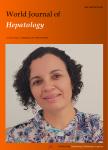Assembly and release of infectious hepatitis C virus involving unusual organization of the secretory pathway
Assembly and release of infectious hepatitis C virus involving unusual organization of the secretory pathway作者机构:Roche Innovation Center Roche Pharma Research and Early Development F. Hoffmann-La Roche Ltd. Molecular Structure Section Laboratory of Viral Diseases NIAID NIH Unité de Virologie Structurale Institut Pasteur and CNRS UMR 3569
出 版 物:《World Journal of Hepatology》 (世界肝病学杂志(英文版)(电子版))
年 卷 期:2016年第8卷第19期
页 面:796-814页
学科分类:1004[医学-公共卫生与预防医学(可授医学、理学学位)] 1002[医学-临床医学] 100401[医学-流行病与卫生统计学] 10[医学]
基 金:Supported by Intramural Program of the National Institutes of Health,National Institute of Allergy and Infectious Diseases(Project No.1 ZIA AI000733-15:Enveloped Virus Glycoprotein/Receptor Interactions)to Edward A Berger,PhD(MSS,LVD,DIR,NIAID) ORISE Senior Fellow award(Award No.1238-1238-03:Department of Energy/Oak Ridge Institute for Science and Education)to Bertrand Saunier,MD,PhD
主 题:Membrane rearrangements Hepatitis C virus Flavivirus replicon Virus assembly and secretion Host cell
摘 要:AIM: To determine if calnexin(CANX), RAB1 and alphatubulin were involved in the production of hepatitis C virus(HCV) particles by baby hamster kidney-West Nile virus(BHK-WNV) cells. METHODS: Using a si RNA-based approach complemented with immuno-fluorescence confocal microscope and Western blot studies, we examined the roles of CANX, RAB1 and alpha-tubulin in the production of HCV particles by permissive BHK-WNV cells expressing HCV structural proteins or the full-length genome of HCV genotype 1a. Immuno-fluorescence studies in producer cells were performed with monoclonal antibodies against HCV structural proteins, as well as immunoglobulin from the serum of a patient recently cured from an HCV infection of same genotype. The cellular compartment stained by the serum immunoglobulin was also observedin thin section transmission electron microscopy. These findings were compared with the JFH-1 strain/Huh-7.5 cell model.RESULTS: We found that CANX was necessary for the production of HCV particles by BHK-WNV cells. This process involved the recruitment of a subset of HCV proteins, detected by immunoglobulin of an HCV-cured patient, in a compartment of rearranged membranes bypassing the endoplasmic reticulum-Golgi intermediary compartment and surrounded by mitochondria. It also involved the maturation of N-linked glycans on HCV envelope proteins, which was required for assembly and/or secretion of HCV particles. The formation of this specialized compartment required RAB1; upon expression of HCV structural genes, this compartment developed large vesicles with viral particles. RAB1 and alpha-tubulin were required for the release of HCV particles. These cellular factors were also involved in the production of HCVcc in the JFH-1 strain/Huh-7.5 cell system, which involves HCV RNA replication. The secretion of HCV particles by BHK-WNV cells presents similarities with a pathway involving caspase-1; a caspase-1 inhibitor was found to suppress the production of HCV particles from a full-length genome.CONCLUSION: Prior activity of the WNV subgenomic replicon in BHK-21 cells promoted re-wiring of host factors for the assembly and release of infectious HCV in a caspase-1-dependent mechanism.



